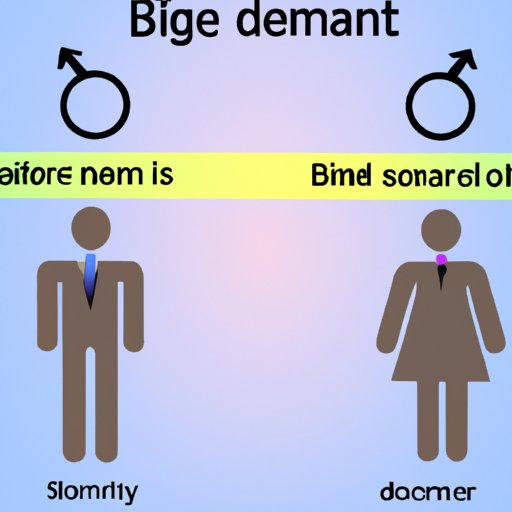Within the realms of anthropology and biology, the investigation of gender classification presents a complex tapestry interwoven with both reproductive physiology and sociocultural constructs. The prevailing narrative in much of Western thought has long asserted a binary understanding of gender—male and female—rooted predominantly in biological determinism. However, this perspective often neglects the intricate realities of human diversity that manifest both biologically and socially. Acknowledging the interplay between biological and social contexts provides a pivotal shift in perspective that warrants exploration.
Biological sex, traditionally defined by chromosomal configurations, such as XX for females and XY for males, serves as the foundation upon which the binary notion of gender is built. However, it is fundamental to recognize that biological sex is not an immaculate demarcation. The existence of intersex individuals—those born with a combination of male and female biological characteristics—challenges the simplistic dichotomy. It is estimated that approximately 1 in 1,500 to 1 in 2,000 live births result in a child with intersex traits, highlighting that biological variations exist within sex classifications.
Furthermore, secondary sexual characteristics often molded by societal expectations can lead to misconceptions regarding the nature of gender identity. Scientifically, we understand that genetic factors, hormone levels, and environmental influences all contribute to an individual’s sexual differentiation. The linear progression from a biological foundation straight to the social conception of gender fails to account for the nuances introduced by these variants.
Transcending biological roots, gender emerges as a profoundly social construct. The social constructionist perspective posits that gender is not merely determined by biological imperatives, but rather shaped and informed by cultural narratives, socio-political frameworks, and historical contexts. Different cultures have historically recognized various gender roles that diverge from the binary lens, suggesting a broader spectrum of identity. For instance, many Indigenous cultures across North America recognize Two-Spirit individuals, a term that encompasses a variety of gender identities beyond the male-female binary. This recognition underlines that varying social constructs of gender can exist concurrently with biological realities.
The concept of cultural relativism becomes essential in this discourse, advocating for an understanding of gender through the lens of cultural context rather than imposing rigid, Western-centric frameworks. Cultural relativism encourages acknowledging the legitimacy of diverse gender identities that do not conform to binary classifications. Societies globally articulate gender in ways that reflect their unique historical experiences and spiritual beliefs, leading to a rich tapestry of identities. In some societies, gender fluidity or multiplicity is celebrated, transforming our understanding of what it means to inhabit certain roles within human interactions.
This recognition of diverse gender expressions challenges reductive perspectives that categorize individuals strictly within a binary framework. The implications of such an approach reach far beyond mere academic discussion; it informs policies, social services, and individual rights. Inclusivity in language, healthcare, and policy development becomes urgent as the dialogue surrounding gender expands to encapsulate a more pluralistic understanding. Recognizing that gender can vary within and across different cultural contexts underscores the necessity for an integrative approach to gender issues.
Despite the scientific awareness of intersex and transgender existence, mainstream narratives often succumb to binary polarization, neglecting the plurality inherent in both biological and social dimensions of gender. Through educational reforms and open discussions, society can cultivate an environment that embraces this plurality rather than stifling it. Initiatives aimed at promoting awareness and understanding can lead to greater empathy and reduced stigma toward individuals who identify outside conventional binaries.
Additionally, psychological research into gender identity reveals that identity formation is a dynamic process influenced by myriad interactions spanning childhood to adulthood. The neurological and psychological aspects of gender identity deserve consideration as they delineate a complex interplay between biological dispositions and social environments. Individuals may experience shifts in gender identity throughout their lives, influenced by personal experiences and societal changes. Such fluidity embodies the very essence of human experience, which often defies simplistic categorization.
The question, “Are there only two genders biologically?” thus metamorphoses from a binary inquiry into a nuanced exploration of the interplay between biology, identity, and society. Such a shift not only promotes curiosity but also enhances discourse surrounding gender, encouraging individuals to contemplate deeply held beliefs about identity and societal structures. Raising awareness of the multifaceted nature of gender can dismantle ingrained stereotypes and open the door to a more inclusive society.
In summation, the juxtaposition of biological and social constructs in the discussion of gender reveals a remarkable spectrum of existence that transcends the simplistic binary model. As anthropologists and citizens of a diverse world continue to advocate for awareness and understanding, it is imperative to maintain an open dialogue that respects cultural relativism while embracing the scientific complexities of human biology. This holistic approach not only honors the myriad identities present within advanced societies but, more importantly, paves the way for future understanding and acceptance. In doing so, society can begin to dismantle the rigid confines of binary thought and foster environments where all individuals can express their true selves authentically.
